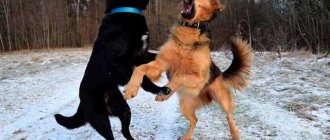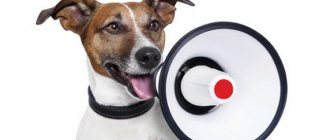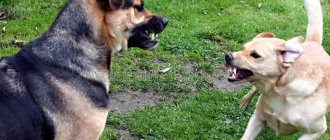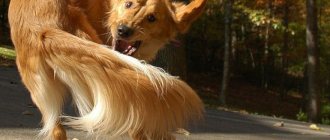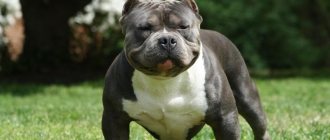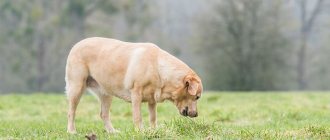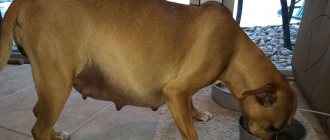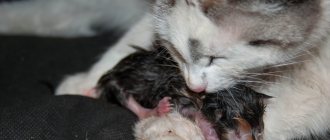Why does a puppy bite?
Biting is natural for a puppy. First of all, this is knowledge of the surrounding world: like babies, small dogs must “test their teeth”.
This is especially evident during the period of teeth change, at the age of 3-7 months. The dog, trying to get rid of discomfort, not only chews various objects in the apartment, but also more often grabs and bites a person.
To make this period easier, you should offer your puppy toys that will massage the gums when chewed. These can be rubber toys or ring ropes for tug-of-war. At this age, it is necessary to begin to accustom the dog to brushing its teeth, and toothbrushes, including silicone ones, have a massage effect.
In puppy games, when a mother teaches her offspring, there is always an element of biting. In this way, dogs, even small ones, establish a hierarchy. It’s the same at the moment of fright - the puppy defends itself with the help of small teeth.
Photo: Clare Black
But if in the pack they make it clear to the puppy that he is playing too hard or that he is biting his brother too hard, in a human family the dog may become confused.
Sequence of actions when biting
The wounded person is given first aid (the wound is washed, treated with an antiseptic, bandaged) and sent to a doctor. At the doctor's office, he is given an injection for rabies. If a dog has an owner who let it off the leash without a muzzle, you can demand compensation from him for damage to health. It is possible to agree on its amount peacefully or, if the culprit does not recognize himself as such, through the court. The sequence of actions is as follows:
- Getting first aid.
- A visit to the nearest police station (a police officer examines the victim and the scene of the incident, documents all this, an aggressive dog can be seized from the owner).
- Search for the owner of the dog if he is not found near the animal (carried out by a police officer or the person who was bitten).
- Contacting a doctor and recording this fact on paper and in video or photo format.
- Establishing contact with the dog’s owner regarding compensation for losses (expenses for a trip to the doctor, payment for torn clothes, medications).
You can also demand compensation from representatives of local authorities, but only if the attacking dog is a stray. It may not be possible to obtain compensation, since an attack by such a dog is considered an accident. But it is necessary to draw attention to the problem, because if a child is bitten by an ownerless dog, who is responsible is the person who fed it, but not the administration, which did not bother to catch the animals in a timely manner.
Animal aggression is sometimes unfounded
Possible consequences of a dog bite
Each situation is individual, so the consequences can be very diverse, both superficial and deep, more serious. In general, when bitten by a street dog, the following consequences are possible:
- The bitten area swells, this indicates injury to the skin.
- Enlarged lymph nodes throughout the body.
- Severe headaches, dizziness, sometimes weakness and nausea.
- Increased body temperature.
- Pain at the bite site.
The most serious consequence is rabies, so you need to see a doctor and get injections for prevention. All of the above conditions do not indicate infection, they only indicate the fact of a bite. If anxiety continues for more than 2-3 days, you should definitely go to a medical facility.
Why does a puppy bite arms and legs?
When playing with a person, the puppy perceives his arms or legs as “prey”. The usual way to catch it is to grab it by biting it. Due to its age, a small pet may not yet understand how hard it bites its owner. And if you don’t teach a dog to bite from childhood, then the animal will carry this “game” into adulthood.
Photo: Giuliano Maiolini
This is fraught with injury to surrounding people and animals, and aggressive behavior. Having the habit of grabbing arms and legs, clothes, the dog will not distinguish how weak its opponent is, and may even bite the child.
Why does a puppy “grab” clothes?
A puppy can bite not only on bare hands or open legs. Clothes, especially loose-fitting ones, seem no less attractive to a small dog for hunting.
Photo: Christopher
Often a person reacts less emotionally to “grabbing” clothing than to biting the hands or body. This fact confirms this type of play as acceptable for the puppy. But an attack only on clothes is fraught with aggression and disobedience in the future.
Causes of bites
In many cases, you can avoid animal aggression by following the rules of communication with unfamiliar dogs:
- You should not get close to the animal, especially while eating;
- Small children who pull animals by the ears or tail should be taken away;
- do not touch puppies - the maternal instinct of protection is triggered in animals;
- when sniffing a strange dog, you should not make sudden movements - it is perceived as a threat;
- At close range you should not look a stranger’s dog in the eyes - this is perceived as a challenge.
There are cases of owners of fighting breeds inciting fighting breeds against people. Persons for such acts face not just an administrative fine for a dog bite, but a real prison term, although this can be difficult to prove.
What to do if your puppy bites
A puppy's habit of biting a person can last a lifetime. Therefore, the owner must be aware that the dog should be weaned from this at an early age.
Photo: Carl Woolnough
Understand the reasons why your puppy might bite.
When a puppy in a pack, playing and exploring the world, causes pain to other dogs, the animal immediately signals this: it yelps and stops playing. Thus, the bitten dog shows that it is in pain and does not intend to play further. This technique should also be used by humans.
- After your puppy bites you, you should let him know that you are in pain, for example, loudly say “Ouch!” and show the consequences of his actions: “you hurt me and I don’t communicate with you” - stop playing with him for a short time. This action will explain to the dog that the game will begin only after he stops biting you.
- When the dog realizes that this version of the game does not work, it will look for an alternative. At this moment, you should switch the puppy’s attention: offer a hunt for a toy, a “non-contact” game, for example, with a ball or tug of war.
- You need to do the same when the puppy bites not only your arms, but also your legs while walking. If attacked, you should stop immediately and wait until the pet lets you go. You should wait a pause of 20-30 seconds and only after that offer the dog a toy.
- If the puppy bites not only during active games, but also when trying to pet him or put on a collar, the absence of such behavior should be positively reinforced. Teach your dog that if he behaves calmly in these situations, he will receive a reward in the form of a treat or toy.
First steps when bitten by a dog
Even the most well-mannered and calm dog, under the influence of negative external factors, can attack a person and cause him bodily harm. What to do if bitten by a dog? The injured person should immediately contact a medical facility - an emergency room or a therapist. Immediately after the incident, you must do the following:
- Stopping the bleeding - if the bite was deep and the bleeding is difficult to stop, you can call an ambulance. When there is little blood, you need to wait until it stops on its own, so the animal’s saliva comes out.
- Washing the wound with antibacterial agents, this can be soap, gel, antiseptic. At this stage, you need to spare no time - a minimum of 10 minutes of processing is required.
- If the wound is shallow, you need to treat it with hydrogen peroxide and bandage it for speedy healing. Otherwise, consult a doctor immediately.
- When painful symptoms occur, you can take a pain reliever.
- The victim is in a state of fright, shock, anxiety - you should take a sedative.
Even if all the steps have been followed and there are no outward symptoms or signs of complications, there is no need to delay going to the doctor. Only a specialist will determine whether there has been infection with infectious diseases and prevent other negative consequences.
Is it necessary to punish
It is important to understand that when weaning a puppy from bad behavior, you should not use punishment. Rough treatment by the owner can frighten the animal and lead to aggression in the dog.
Photo: Matthew
Negativity on the part of the owner will reinforce in the puppy the idea that playing is painful and that exploring the world around him is unacceptable. By punishing a pet, a person risks turning a kind, sweet puppy into a downtrodden, timid animal.
Dominant dog aggression - causes and signs
More than half of the cases of aggressive behavior of animals directed against humans relate to aggression towards family members, i.e. aggression within a social group. Moreover, in 72% of cases it was about the aggression of rivalry or the so-called aggression of the struggle for leadership. In 56 dogs (approximately 38%), the level of aggression ranged from moderate to severe.
Leadership aggression directed against family members always occurs in one of the two situations described below. A dog and a family member compete for possession of something:
- When a family member tries to take food or objects from the dog (eg bones, toys, napkins) or approaches the dog while he is holding any of these objects near him.
- When one family member approaches or touches another family member who is the dog's "pet" or another dog (such as a female in heat).
- When a family member approaches a dog lying in its place, or interferes with its resting or sleeping (as a rule, it is believed that this is competition for a place to rest or sleep).
- When a family member enters a room occupied by a dog or in a narrow hallway wants to pass the dog in the opposite direction.
The owner demonstrates his superiority over the dog by his behavior. This behavior includes:
- scratching, brushing, bathing the dog, performing various medical procedures, wiping;
- touching the paws or face of an animal;
- situations when the owner lifts, pushes or pulls the dog;
- puts a collar on her, tugs or pulls on her leash;
- stares at her or threatens her, swears or shouts at her, constantly commands her, hits her;
- grabs her or leans over her.
Many of these actions are not perceived by the people themselves as a demonstration of superiority. However, it is precisely this behavior that often causes aggression on the part of the dog to fight for leadership or aggression of self-assertion, because it is very similar to demonstrating superiority among dogs.
Other typical signs of aggression in the struggle for leadership
Owners often claim that the dog’s attack was unprovoked, while the dogs themselves, who suddenly showed aggression in situations that they perceived normally the day before, are called “capricious” or unpredictable.
Often the attacks are more vicious in nature than other types of aggressive behavior and can result in skin lesions. Dog bites can be very deep and leave scars. Often owners have to see a doctor or even go to the hospital.
During an attack, the dog does not look like itself, grins, growls, and lunges. Almost all owners note a strange sparkle in their dogs' eyes . In addition, other aggressive gestures may be observed, for example, raised ears and tail, ruffled hair on the neck and back, and a fixed gaze directed at the target of the attack.
Immediately after the attack, the dog may again cuddle up to the owner, which the owner happily perceives as an “apology.”
Often the dog will exhibit species-typical behavior that is close to a fight for leadership, such as staring at family members until they look away, or “putting himself above” by placing his front paws or muzzle on a person's knees or shoulders. Such dogs are most often friendly and harmless towards strangers, so veterinarians have the opinion that the problem is not in the dog, but in people. However, this problem only manifests itself in the relationship between the dog and family members and only becomes obvious to strangers if they are in the house for more than one day.
People who have extensive experience with dogs, such as trainers or veterinarians, almost never have problems with such dogs. However, there are some real tough nuts among dogs who behave aggressively in their quest for leadership (they end up in dog shelters) and are not impressed by the demonstration of superiority from experienced professionals. These dogs can become aggressive over the smallest things, such as when someone tries to lead them in a direction they don't want to go.
Dogs are not necessarily aggressive towards all family members. It is much more common that they are more likely to show aggression and/or behave more aggressively towards certain people living in the house.
With the exception of the situations of competition and confrontation described above, which are a typical cause of aggression in the struggle for leadership, dogs, in general, behave friendly towards family members. They are generally obedient, and like all other dogs, ask for food and some attention. However, almost without exception, the owners of such dogs call them stubborn, headstrong and not obedient enough. When a dog really wants to do something else, such as play with or fight with another dog, he is likely to completely ignore commands from family members. The owners understand that the dog lacks respect for them.
Many owners are able to recognize the first symptoms of incipient aggression, for example, when the animal tenses up and begins to look at the owner sideways and with a strange look. In this case, the owner knows that he needs to immediately stop his actions in order to avoid aggression from the dog. In general, family members understand the need to be careful around the dog in certain situations. It often turns out that the problem of dog aggressiveness already existed long before the meeting with a specialist, it’s just that the owners have until now avoided the dog’s attacks, fulfilling its wishes.
These dogs should not be physically punished or severely scolded for their aggressive behavior because... this inevitably causes an even stronger manifestation of aggression. Most often, quite a long time after the problem arises, the owners try to respond with force to force in order to restrain the dog’s aggression, but the animal’s angry reaction stuns them. In essence, owners are not prepared to go through with the fight with their dog, as might a trainer who trains service dogs for police work. They don't know how to fight a dog without it biting you. After one or two bites, such people give up and stop fighting, which further strengthens the dog’s confidence in its superiority over its owner.
Family members admit to being afraid of the dog. However, according to them, this was not always the case; the dog became aggressive towards the owner and other family members.
Some of these dogs set completely arbitrary and rather unusual rules of behavior for their owners:
- For example, the master is not allowed to open a certain drawer in the kitchen cupboard, or the housewife is not allowed to go to bed before the master. The examples given are taken by the author from his practice. In the case of a woman who was only allowed to go to bed after her husband, she ended up having to sleep on the sofa every time her husband worked the night shift.
- In another case, a German shepherd “ordered” the owner’s daughter to let her out through the back door into the garden, each time uttering a deep, guttural growl. Two deep wounds from being bitten for “disobedience” convinced the girl of the seriousness of the dog’s intentions, and she did not try to contradict her.
Shocked by the dog’s vicious behavior and completely not understanding their pet, otherwise such a sweet and playful animal, the frequency owners begin to assume that he has a serious brain disease. In many of the most severe cases, correction of deviant behavior can bring only partial success. Many dogs with pronounced aggressive behavior in the struggle for leadership, even despite the owner’s pedantic implementation of all the recommendations of an ethologist, continue to threaten or attack family members, and ultimately it becomes too dangerous to leave such a dog in the house.
Common mistakes
You cannot deliberately “prank” the puppy; do not encourage him to hunt for your hands. For “hunting” use toys, dog ropes, balls.
Only positive emotions should be associated with the owner’s hands
Remember not to punish your puppy and be patient. Often, when a person does not see success in raising a puppy, he gives up. The owner returns to physical abuse or succumbs to the small animal, which will annoy the owner with a bad habit throughout, perhaps, his entire life.
What to do if an adult dog bites
It is possible to wean an adult animal with a mature character from biting, but it will be much more difficult to do.
Why does an adult dog bite?
An adult dog can bite not only during play. She can show her aggression, show “who’s boss.” Most often, the reason is lack of education in puppyhood, when the puppy was not weaned off the habit of biting in time.
What happens if the dog is not weaned from the habit of biting in time (video)
By trying to bite or snarling, a dog may be showing fear, which is how it can defend itself.
Just like humans, dogs have different personalities and temperaments. There are “biting” breeds, and there are dogs that do not bite, even when they are scared or in pain.
How to stop an adult dog from biting
When correcting the behavior of an adult animal, it is important to understand the motives for biting: whether the dog bites you in a game or in this way shows aggression.
If a dog bites only when playing, first of all, you should act as in the case of puppies: show that you are in pain, that you will not play with the animal until it stops biting.
Photo: Amanda Kae's Photoz
Avoid games in which your dog might bite your arms, legs or clothing.
Teach your dog the command “Foo!” and use it if the dog grabs you.
Having played and bitten, the dog may not unclench its jaws. In this case, they should be carefully released without the use of physical force.
The use of harsh punishments is unacceptable. At most, if the dog shows signs of aggression, you can use a small physical suggestion: grab it by the withers and shake it slightly.
Procedure for receiving compensation
The legislation of the Russian Federation does not provide for criminal or administrative liability for the owner of the dog. However, civil liability often arises. According to Art. 1064 of the Civil Code of the Russian Federation, damage that was caused to a person’s person or property is subject to compensation in full. Art. 151 of the Civil Code of the Russian Federation provides for the possibility of compensation for moral damage for physical and moral suffering. That is why, in order to receive compensation, you must adhere to the following algorithm:
- Recording the damage caused.
- Go to the emergency room.
- Contacting the police.
- Search and identification of the owner.
- If necessary, go to court to forcibly recover funds.
Each of these steps will be covered in more detail below.
Recording damage, animal and owner in the photo
What should you do first if you are bitten by a dog on the street? To begin with, provide first aid to the victim, then record the injuries caused. It is advisable to do this as quickly as possible so that the wounds are fresh and do not have time to scar and heal. To do this, you do not need to undergo an examination or examination; you can simply photograph the damage.
Note! If the animal does not escape after the attack, you need to photograph it or videotape the fact of its movement without a muzzle and a leash. If possible, you need to capture the owner to facilitate the process of identifying him.
It is important that the photos and videos are of high quality and illustrate in detail the damage, wounds and destruction. If the technology suggests the ability to determine geolocation, it should be noted, as well as the time of the incident. This will form a complete evidence base.
Going to the emergency room
What to do if a dog bites you, regardless of whether it has an owner or not? You need to go to the emergency room or emergency room, where specialists will conduct an examination and prescribe a course of therapy. If the wounds are deep and bleeding begins, you need to call an ambulance. This stage is mandatory, regardless of whether the victim plans to seek compensation or not. This step is primarily prevention and prevention of possible infections. Only timely consultation with a doctor will allow rabies and other infections to be detected in the early stages.
When a person wants to recover damages from the perpetrator, he needs to take documents confirming the fact of treatment and examination by a doctor. Such certificates will serve as evidence in law enforcement agencies.
Contacting the police
If the victim did not see the owner and could not find him in the future, he should contact the police department. You can also call the local police officer at your place of registration. If you contact a medical institution, you can ask the doctors to call a police officer to file a statement.
The statement must indicate the details of the incident, describe the area, the external signs of the dog and its owner. It is advisable to indicate contacts and descriptions of witnesses who can confirm and describe the situation. A criminal case is unlikely to be initiated, but the received statement is the basis for the district police officer to conduct an explanatory conversation with the dog owner.
A police officer should provide assistance in drawing up a statement, but it is advisable to understand the essence and structure of the document in advance. That is why you should download and fill out the form in advance.
Identifying the dog's owner
This is an important stage, which is of particular importance if the owner was not present at the time of the attack. It is necessary to establish the identity in order to determine whether the animal has rabies or other infections, and to make attempts to peacefully resolve the conflict.
The police are looking for the culprit if the victim has written a statement, but if not, then you will have to look for it yourself. The most favorable and productive way to find the owner is to interview neighbors, eyewitnesses and other witnesses.
What to do if you can’t stop your dog from biting on your own
Each dog must have an individual approach. And if our advice will help someone immediately wean their pet from biting, then some owners will have to work hard with their pets.
Don't give up and don't get angry with your dog. If you feel that your activities are not bringing success, seek qualified help.
Dog education and training specialists have knowledge of canine psychology and will be able to correct your pet’s behavior.
Photo: Edward Liu
Solving dog behavior problems is long and hard work. But with the right approach: without using punishment, without reinforcing bad behavior, or distracting the puppy, the result will be worth it. Your dog will become well-mannered and will know that the owner’s hands are not “prey”, but the best thing in his life.

